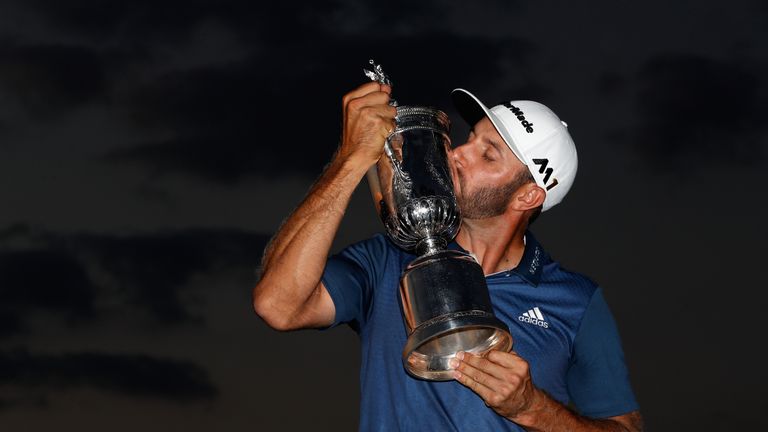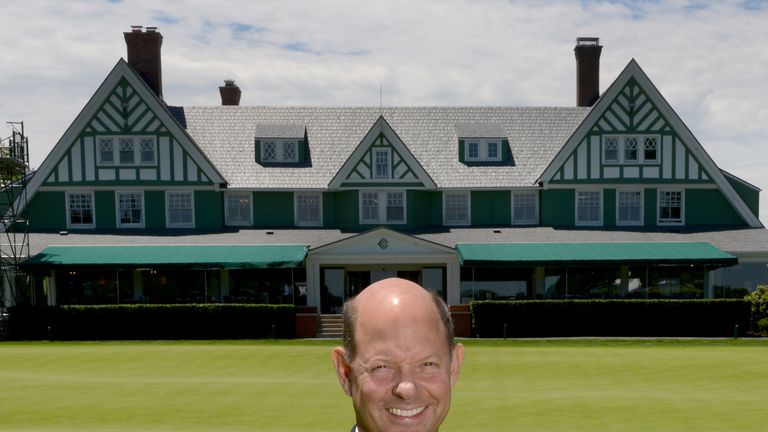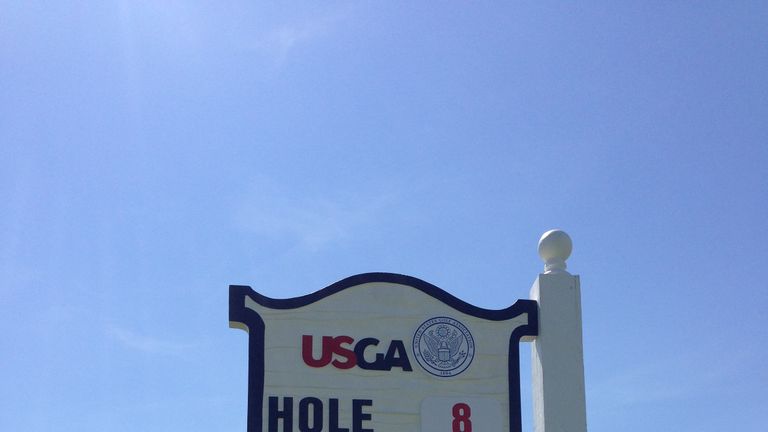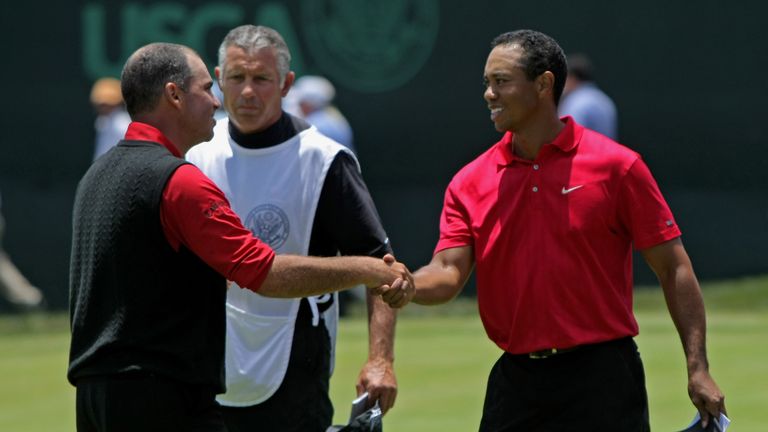Ewen Murray: US Open farce must never be repeated
Wednesday 22 June 2016 18:29, UK
Ewen Murray reflects on the "embarrassing" incidents that soured a fascinating US Open at historic Oakmont, and feels the USGA should be restructured to avoid a repeat performance in the future.
It will be a while before the 2016 edition of the US Open will slip from the memory.
The return to Oakmont Country Club was eagerly anticipated. The "Silver Scot", Tommy Armour won the championship there in 1927, the year the inaugural Ryder Cup was played. Jack Nicklaus won the first of his 18 majors at Oakmont in 1962 and, 11 years later, Johnny Miller played one of the best 18 holes in the history of the game - a 63 to win his national title, a score that still stands today as the equal lowest in the four majors.
The day before the latest US Open began, Oakmont was a picture. A course lovingly prepared by a talented team of green staff. Despite a deluge from leaden skies on Thursday which led to three suspensions of play, Oakmont was returned to perfection by the aforementioned dedicated workers.
With the weather set fair for the rest of the event, the US Open enjoyed its usual story lines. Andrew Landry of Austin,Texas became the lowest first round scorer over this feared course with a four-under-par 66. Round two, played over two days, came to an end on Saturday and, after round three, Ireland's Shane Lowry had a handsome lead of four. All good with an exciting final 18 holes to come.
Sadly, Sunday turned out to be a day for the sport to forget. On the fifth green, Dustin Johnson, Lowry's closest challenger, saw his ball shift by a dimple under its own weight. He immediately called a referee and explained the ball had moved a fraction but it was not he who had caused it to move. This was confirmed by his playing partner, Lee Westwood.
After a few seconds, the referee had accepted the explanation and play continued. Well over an hour and seven holes later, the USGA, the governing body of golf stateside who run the US Open, thought they had found something that was incorrect about what happened at the fifth. They decided to tell Dustin, and the players who were in contention, that there could be a penalty at the end of the round.
So who was leading now? Who was two behind, or was it one, or hang on, it might be three! Their calamitous handling of the situation turned a fascinating championship into an embarrassment.
I have been a small part of Sky Sports' broadcast team at the US Open since 1993. There have been some memorable moments from great champions at some of America's most treasured venues. What happened on Sunday must never be repeated and those responsible for the idiocy of it all should find a future outside of golf.
A few years ago, much praise was heaped on Mike Davis, the executive director of the USGA. Here was a man that could set up courses like no other. He turned par-fours into threes, par-fives into fours. He introduced par-threes at over 300 yards and has a plan to present a par-five at 700 yards.
To make the course seem tough, he and his team reduced the par of 72 by two shots. Here was a man who would transform the US Open and make it the best event in the game. Davis, as you would expect, enjoyed all of the attention and why not? After all, he had delivered good championships.
Congressional, in the nation's capital, of Washington was conquered by Rory McIlroy in soft conditions. A return to Merion, an iconic American course that is a huge part of American golfing history, was successful and Pinehurst, revamped by Ben Crenshaw and Bill Core, produced an excellent champion in Martin Kaymer in 2014. The two years since then have been regrettable.
In 2015, the championship was held outside of Seattle. The course, Chambers Bay, nestled by some of the best scenery in the world. A course that had eight years to prepare for the US Open. The result? A design a landscape gardener would be ashamed of, five holes the fans couldn't see and 18 holes that featured tees and fairways, but sadly no greens.
When in Davis's position, praise and criticism comes with the package. If you bask in one, you have to accept the other and there will be plenty of the latter after Oakmont. I believe it's time for a total restructuring of the USGA to shake up the game worldwide.
They are the organisation who didn't listen to Arnold Palmer, Jack Nicklaus and Gary Player several years ago when the "big three" warned the golf ball was too fast and had to be reeled in and regulated. The result of their decision to do nothing? 350 yards is no longer a huge drive, it's almost the norm. Golf clubs bought more land to stretch the yardage which meant green superintendents spent more cash on fertilisers, and rounds that took around the three and a half hour mark have been extended by over an hour.
Golfers are leaving the game because it takes too long, courses that flourished for years are now housing estates. Worryingly, a large percentage of "missing" players are aged between 25 and 45. This organisation allowed anchoring putting continue for 25 years before banning it. Easier surely to limit the length of the putter.
Obsessed with par or worse winning their Open, they wanted the greens at Oakmont to be 14 on the stimpmeter. The only thing that surprised me was that more golf balls didn't oscillate under their own steam.
The USGA insist on a Monday play-off over 18 holes if their championship ends in a tie on Sunday. Never mind the fans who buy final day tickets to see a conclusion on Sunday evening. Never mind you at home who might have to miss the excitement of the final few holes and the crowning of the champion.
Instead of a magical atmosphere created by 40,000 fans on the Sunday, it's old Archie, a few mates and his Labrador the following day. Logistically, the Monday play-off is a disaster. It's something no one wants, apart from the USGA. The television companies from the USA, Japan, Australia and those of us in Europe have to re-book air tickets, hotels and car hire to accommodate a play-off at a cost of hundreds of thousands of dollars. I'm surprised the TV companies haven't applied pressure to change this dated nonsense.
I've always looked forward to the US Open and have some wonderful memories over these 23 years. Corey Pavin's four-wood to the 18th at Shinnecock, and, 70 years after Bobby Jones won, his namesake Steve won at Oakland Hills. A much missed friend, Payne Stewart's win in '99, the glorious Tiger Woods years, the fairytale win of Michael Campbell and that historic return to Merion to witness Justin Rose's finest moment. The US Open has been fabulous.
Looking at the social media comments of Tiger, Jordan Spieth and Rory McIlroy, after the shambolic end to the 116th playing of the US Open, this organisation requires a meeting to plan for the years ahead and it's a meeting of the utmost importance.
The golfing world can easily do without the US Open. After all, three majors are contested in the States. Without it, the USGA would drift into obscurity. The game is expanding in the Far East, Australia, South Africa and Europe. These are words of warning, nothing is forever.
The USGA have achieved much in years gone by. They have helped people join this great sport which is healthy for its participants. They have encouraged underprivileged kids to golf, as well as socially enhancing the leisure time of many, so I give them some credit there, but Sunday was farcical.
When the dust settles, they must take a good look at themselves and join the real world.
Lost in translation was the winner. Dustin Johnson is a player who had it all, apart from a major championship title. With the news of a possible penalty reaching the fanatical Pittsburgh crowd, the Americans did what they do so well. They lifted Johnson, placed him on a magic carpet and roared him home.
My abiding memory of Oakmont will be the quality of golf produced by the new champion in a situation you wouldn't wish on you're worst enemy. His three closing shots on one of the toughest and most elegantly designed holes were the stuff of dreams.
Shane Lowry is much too decent a chap to say the ludicrous situation affected him, so I'll say it. Having played his way back into contention after a rough passage on the front nine, his momentum was brought to an abrupt halt.
The only good news from this year's US Open is that America has a champion to be be proud of. Great player, now a grand individual who has faced and conquered his demons. The ignorance and arrogance of the uniformed amateurs will pass and while it does, the floodgates for Dustin will open. The future for Major Johnson is something to embrace and look forward to.
And at the end of a harsh column, and one which has not been enjoyable to write, one final question: what was the penalty shot for?
Time to walk Annie and Islay up the South Downs and get back to normality I think.














